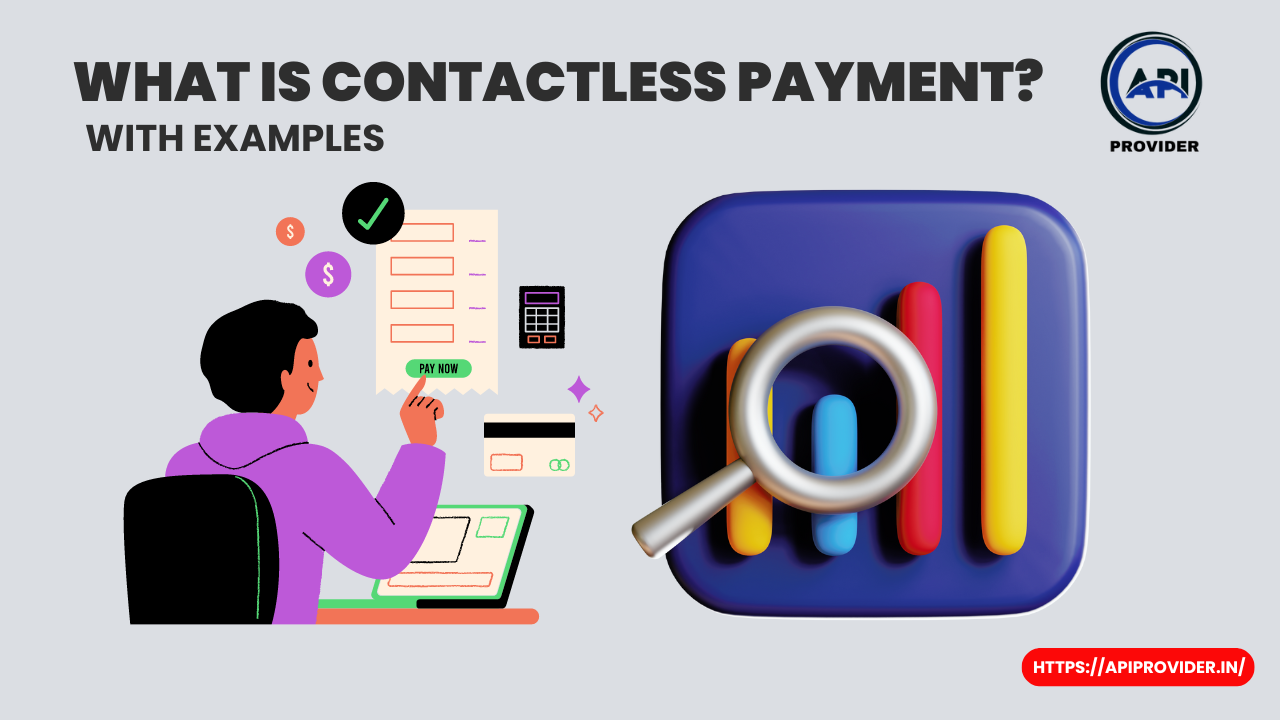Contactless Payment: Have you ever waved your card or phone near a payment terminal and completed a transaction in seconds? That’s the magic of contactless payment. This modern method of payment has transformed how we make transactions, offering speed, convenience, and enhanced security. In today’s fast-paced world, contactless payments have become a crucial component of our daily lives. But how exactly does this technology work? Let’s dive in and explore.

How Contactless Payment Works
Technology Behind Contactless Payments
Contactless payments rely on Near Field Communication (NFC) technology. NFC allows devices to communicate with each other when they’re close together—typically within a few centimeters. This technology is embedded in contactless cards, smartphones, and other wearable devices, enabling them to interact with payment terminals seamlessly.
Read More…
Steps Involved in a Contactless Transaction
- Initiation: Hold your contactless-enabled card or device near the payment terminal.
- Authentication: The terminal reads the NFC chip and requests payment information.
- Processing: The payment information is transmitted to the acquiring bank for authorization.
- Confirmation: The terminal displays a confirmation message, and the transaction is complete.
Security Measures
Contactless payments incorporate multiple layers of security, including encryption and tokenization. Each transaction generates a unique code, making it difficult for fraudsters to steal and reuse your payment information. Additionally, contactless payments often require additional authentication, such as a PIN or biometric verification, for transactions above a certain amount.
Benefits of Contactless Payment
Speed and Convenience
One of the biggest advantages of contactless payments is the speed. Transactions can be completed in a matter of seconds, which is significantly faster than traditional payment methods like chip and PIN or cash.
Enhanced Security
Contactless payments are designed to be secure. The use of unique transaction codes and encryption helps protect against fraud. Plus, because you don’t have to hand over your card or device to a cashier, there’s less risk of your information being compromised.
Improved Customer Experience
The ease and speed of contactless payments contribute to a better overall customer experience. Shoppers can check out quickly, reducing wait times and enhancing satisfaction.
Types of Contactless Payment Methods
Contactless Credit and Debit Cards
Many banks issue contactless-enabled credit and debit cards that allow you to make payments by simply tapping your card on the terminal.
Mobile Wallets
Mobile wallets, such as Apple Pay, Google Pay, and Samsung Pay, store your payment information securely on your smartphone. You can make payments by holding your phone near the terminal and authenticating the transaction with your fingerprint, face recognition, or a PIN.
Wearable Devices
Smartwatches and fitness trackers equipped with NFC technology can also be used for contactless payments. These devices offer the added convenience of making payments without needing to carry your phone or wallet.
Examples of Contactless Payment Systems
Apple Pay
Apple Pay allows users to make payments using their iPhone, iPad, Apple Watch, or Mac. It’s widely accepted in stores, online, and within apps. Apple Pay uses a process called tokenization to secure your payment information.
Google Pay
Google Pay is available on Android devices and offers a similar functionality to Apple Pay. It supports in-store, online, and in-app purchases, providing a seamless payment experience.
Samsung Pay
Samsung Pay works on Samsung devices and uses both NFC and Magnetic Secure Transmission (MST) technology, making it compatible with a broader range of payment terminals.
Contactless Payment in Different Industries
Retail
Retailers have widely adopted contactless payments due to their speed and convenience. They help reduce checkout times and improve the shopping experience.
Public Transportation
Many public transportation systems, such as London’s Oyster Card and New York’s OMNY system, have implemented contactless payments to streamline fare collection and reduce bottlenecks.
Hospitality and Dining
Restaurants and hotels use contactless payments to offer a smoother payment process for their customers, allowing for quicker table turnovers and a more pleasant dining experience.
Global Adoption of Contactless Payments
Adoption in Developed Countries
In developed countries, contactless payments are becoming the norm. Countries like the UK, Australia, and Canada have seen widespread adoption, with many merchants offering contactless payment options.
Adoption in Developing Countries
Developing countries are also embracing contactless payments, although at a slower pace. Efforts to increase financial inclusion and the proliferation of mobile devices are driving this growth.
Case Studies of Successful Implementations
- London’s Oyster Card System: A prime example of contactless payment success in public transportation.
- Starbucks Mobile Order and Pay: Demonstrates the convenience and efficiency of contactless payments in the hospitality sector.
Challenges and Limitations of Contactless Payments
Infrastructure Requirements
The adoption of contactless payments requires investment in infrastructure, such as NFC-enabled terminals, which can be a barrier for some merchants.
Security Concerns
While generally secure, contactless payments are not entirely free from risks. Skimming devices and other forms of fraud can still pose threats.
User Adoption and Education
Some consumers are still wary of adopting new technologies. Education and awareness campaigns are essential to increase user confidence in contactless payments.
Future Trends in Contactless Payments
Integration with IoT (Internet of Things)
The future of contactless payments may see deeper integration
with the Internet of Things (IoT), allowing various connected devices to facilitate payments seamlessly. Imagine your smart fridge ordering groceries and paying for them automatically, or your car paying for fuel at the pump without you needing to step out.
Biometric Authentication
As security measures evolve, biometric authentication, such as fingerprint scanning, facial recognition, and even iris scanning, will become more prevalent. This will enhance security and streamline the payment process, making it even more convenient.
Expansion into New Markets
As technology advances and infrastructure improves, contactless payments will expand into new markets, including remote and rural areas, bringing financial services to underserved populations.
Contactless Payment vs. Traditional Payment Methods
Comparison with Cash Payments
Contactless payments are faster and more secure than cash payments. There’s no need to handle physical money, reducing the risk of theft and minimizing the spread of germs—a significant consideration in a post-pandemic world.
Comparison with Chip and PIN Transactions
While chip and PIN transactions are secure, they are slower than contactless payments. Contactless methods eliminate the need to enter a PIN for every transaction, speeding up the process.
Comparison with Online Payments
Online payments require internet access and can involve multiple steps, such as entering card details and verifying through OTPs. Contactless payments are quicker and can be done offline, making them more versatile for in-person transactions.
Security Measures for Contactless Payments
Encryption and Tokenization
Encryption converts your payment information into a code that only authorized parties can decode. Tokenization replaces sensitive information with a unique identifier or token that cannot be reused, adding an extra layer of security.
Fraud Detection and Prevention
Advanced algorithms and machine learning models monitor transactions in real-time to detect and prevent fraudulent activities. Any unusual patterns trigger alerts, ensuring swift action against potential fraud.
Best Practices for Users
Users should always keep their cards and devices secure, monitor their transaction history regularly, and report any suspicious activities immediately. Using biometric authentication adds an extra layer of security.
How to Set Up and Use Contactless Payments
Setting Up Mobile Wallets
- Download the mobile wallet app (e.g., Apple Pay, Google Pay, Samsung Pay) from your device’s app store.
- Open the app and follow the prompts to add your card information. This may involve scanning your card or entering details manually.
- Verify your card with your bank if required.
Linking Bank Accounts and Cards
Ensure that your bank account or card is compatible with contactless payments. Link your card to your mobile wallet or wearable device by following the instructions provided by the service.
Using Contactless Payments for the First Time
Hold your card or device near the payment terminal. For mobile devices, authenticate the transaction using your fingerprint, face recognition, or PIN. The terminal will confirm the transaction, and you’re done!
Impact of COVID-19 on Contactless Payments
Surge in Usage During the Pandemic
The COVID-19 pandemic significantly accelerated the adoption of contactless payments. Concerns about hygiene and social distancing led more people to opt for contactless methods to avoid handling cash and reduce physical contact.
Changes in Consumer Behavior
Consumers have become more comfortable with digital transactions. Many who were previously hesitant about contactless payments now prefer them for their convenience and safety.
Long-term Effects
The shift towards contactless payments is likely to be permanent. Businesses and consumers alike have seen the benefits, and this trend is expected to continue growing even as the pandemic subsides.
Real-life Examples of Contactless Payments
Case Study: Starbucks Mobile Order and Pay
Starbucks allows customers to order and pay through their app, enabling a seamless experience from order to pickup. This has enhanced customer convenience and streamlined operations.
Case Study: London’s Oyster Card System
The Oyster Card system in London is a prime example of contactless payments in public transportation. It has reduced congestion at ticket counters and made commuting more efficient.
Case Study: Disney MagicBands
Disney’s MagicBands integrate contactless payment with park access, hotel room entry, and ride reservations. This innovation has significantly enhanced the guest experience.
FAQs
What is the maximum amount for a contactless payment?
The maximum amount for a contactless payment varies by country and bank. Typically, there’s a limit (e.g., $100 or £45) for which no PIN is required. Transactions above this limit may require additional authentication.
Are contactless payments safe?
Yes, contactless payments are secure. They use encryption and tokenization to protect your information, and each transaction generates a unique code, making it difficult for fraudsters to replicate.
Can I use contactless payments internationally?
Yes, you can use contactless payments internationally, provided the merchant accepts contactless transactions and your card or mobile wallet is enabled for international use.
What should I do if my contactless card is lost or stolen?
If your contactless card is lost or stolen, contact your bank immediately to report it. They can block the card to prevent unauthorized transactions and issue a replacement.
How do I know if my card is contactless-enabled?
Look for the contactless symbol (a wave or radio signal icon) on your card. If you see this symbol, your card is contactless-enabled.
